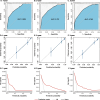Risk factors and clinical risk stratification of distant metastasis in early-stage lung cancer in never smokers
- PMID: 40533740
- PMCID: PMC12175467
- DOI: 10.1186/s12957-025-03892-1
Risk factors and clinical risk stratification of distant metastasis in early-stage lung cancer in never smokers
Abstract
Background: Risk factors for distant metastasis in early-stage lung cancer in never smokers (LCINS) remain poorly understood. This study aimed to identify key risk factors and to develop a clinical risk stratification model for early-stage LCINS.
Methods: We retrospectively analyzed patients diagnosed with early-stage LCINS at West China Hospital, Sichuan University, from 2015 to 2020. Univariable and multivariable Cox regression analyses were performed to identify independent risk factors for distant metastasis. A predictive model was developed and internally validated using bootstrap resampling, with performance assessed by the concordance index (C-index), area under the receiver operating characteristic curve (AUC), calibration plot, and decision curve analysis.
Results: A total of 1,406 patients with pathological stage I-II LCINS were included, among whom 76 (5.41%) developed distant metastasis during follow-up. Multivariable Cox regression analysis revealed that independent risk factors included advanced pathological T and N stages, higher consolidation-to-tumor ratio, and histologic subtype, particularly solid/micropapillary predominant adenocarcinoma. Based on these predictors, a predictive model was developed, demonstrating strong discrimination with a C-index of 0.799 and AUC values of 0.809, 0.791, and 0.783 for predicting 1-, 2-, and 3-year distant metastasis, respectively. Calibration and decision curve analyses confirmed the reliability and clinical utility of the model.
Conclusions: This study identified risk factors and developed a clinical risk stratification model for distant metastasis in early-stage LCINS. This validated model enables risk stratification and personalized monitoring to facilitate early detection of distant recurrence in LCINS.
Keywords: Distant metastasis; Lung cancer in never smokers; Predictive model; Risk factors.
© 2025. The Author(s).
Conflict of interest statement
Declarations. Ethics approval and consent to participate: This is an observational study. The Institutional Review Board of West China Hospital, Sichuan University has confirmed that no ethical approval is required. Consent for publication: All authors gave consent for the publication of this study. Competing interests: The authors declare no competing interests.
Figures




Similar articles
-
Establishment of a prognostic nomogram and risk stratification system for patients with distant-metastatic hepatocellular carcinoma: A population-based study.Medicine (Baltimore). 2025 Jun 13;104(24):e42834. doi: 10.1097/MD.0000000000042834. Medicine (Baltimore). 2025. PMID: 40527819 Free PMC article.
-
Development of a prognostic nomogram and risk factor analysis for survival in H. pylori-positive non-cardia gastric adenocarcinoma patients.Transl Cancer Res. 2025 May 30;14(5):2822-2834. doi: 10.21037/tcr-24-1776. Epub 2025 May 26. Transl Cancer Res. 2025. PMID: 40530114 Free PMC article.
-
IASLC grading system predicts distant metastases for resected lung adenocarcinoma.J Clin Pathol. 2025 May 25;78(6):409-415. doi: 10.1136/jcp-2024-209649. J Clin Pathol. 2025. PMID: 39168612 Free PMC article.
-
Predicting Severe Radiation Pneumonitis in Patients With Locally-Advanced Non-Small-Cell Lung Cancer After Thoracic Radiotherapy: Development and Validation of a Nomogram Based on the Clinical, Hematological, and Dose-Volume Histogram Parameters.Clin Lung Cancer. 2025 Jul;26(5):393-406. doi: 10.1016/j.cllc.2025.02.009. Epub 2025 Feb 21. Clin Lung Cancer. 2025. PMID: 40087057
-
Prevalence and odds of anxiety and depression in cutaneous malignant melanoma: a proportional meta-analysis and regression.Br J Dermatol. 2024 Jun 20;191(1):24-35. doi: 10.1093/bjd/ljae011. Br J Dermatol. 2024. PMID: 38197404
References
-
- Bray F, Laversanne M, Sung H, Ferlay J, Siegel RL, Soerjomataram I, et al. Global cancer statistics 2022: GLOBOCAN estimates of incidence and mortality worldwide for 36 cancers in 185 countries. CA Cancer J Clin. 2024;74(3):229–63. - PubMed
-
- Sung H, Ferlay J, Siegel RL, Laversanne M, Soerjomataram I, Jemal A, et al. Global Cancer Statistics 2020: GLOBOCAN Estimates of Incidence and Mortality Worldwide for 36 Cancers in 185 Countries. CA Cancer J Clin. 2021;71(3):209–49. - PubMed
-
- Kelsey CR, Marks LB, Hollis D, Hubbs JL, Ready NE, D’Amico TA, et al. Local recurrence after surgery for early stage lung cancer: an 11-year experience with 975 patients. Cancer. 2009;115(22):5218–27. - PubMed
MeSH terms
Grants and funding
LinkOut - more resources
Full Text Sources
Medical

